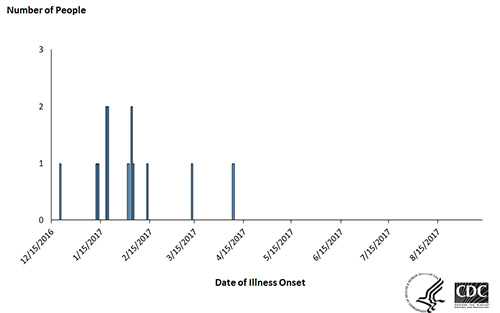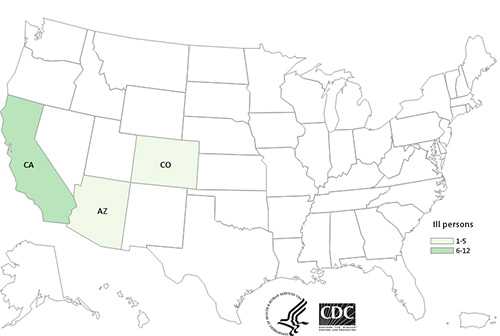Multistate Outbreak of Salmonella Anatum Infections Linked to Imported Maradol Papayas
Posted September 14, 2017 3:45 PM ET
This outbreak is one of four separate outbreaks currently under investigation that are linked to imported Maradol papayas from Mexico. For information on the other outbreaks, please visit the Active Salmonella Outbreaks webpage.
Highlights
- Read the Advice to Consumers, Restaurants, and Retailers >>
- This outbreak is one of four separate outbreaks currently under investigation that are linked to imported Maradol papayas from Mexico.
- This past spring, CDC, public health and regulatory officials in several states, and the U.S. Food and Drug Administration investigated a multistate outbreak of Salmonella Anatum infections.
- Fourteen people infected with the outbreak strain of Salmonella Anatum were reported from three states.
- Illnesses started on dates ranging from December 20, 2016, to April 8, 2017.
- Five ill people were hospitalized. One death was reported from California.
- On September 4, 2017, FDA testing identified the outbreak strain of Salmonella Anatum from a sample taken from an imported papaya at the U.S.-Mexico border.
-
Epidemiologic, laboratory, and traceback evidence indicates that Maradol papayas imported by Bravo Produce Inc. of San Ysidro, California, are the likely source of this multistate outbreak.
- On September 10, 2017, Bravo Produce Inc. recalled Maradol papayas packed by Frutas Selectas de Tijuana, S. de RL de CV.
- The papayas were distributed to California from August 10 to August 29, 2017.
- CDC recommends that consumers not eat, restaurants not serve, and retailers not sell recalled Maradol papayas imported by Bravo Produce Inc.
- If you aren’t sure if the papaya you bought is a recalled Maradol papaya from Bravo Produce Inc., ask the place of purchase. Restaurants and retailers can ask their suppliers.
- When in doubt, don’t eat, sell, or serve papayas; just throw them out.
- Wash and sanitize countertops as well as drawers or shelves in refrigerators where Maradol papayas were stored.
- A review of the CDC PulseNet database identified six more ill people with the same DNA fingerprint of Salmonella Anatum who got sick more recently. CDC is investigating to determine if these more recent illnesses are also linked to Maradol papayas imported by Bravo Produce, Inc.
- FDA continues testing papayas from Mexico to see if other papayas from other farms are contaminated with Salmonella. Investigations are ongoing to determine if additional consumer warnings are needed beyond the advice not to eat papayas from the specific importer given in this notice, and from specific farms given in web postings about the other Salmonella outbreaks linked to Maradol papayas. CDC will provide updates when more information is available.
Initial Announcement
Introduction
This outbreak is one of four separate outbreaks currently under investigation that are linked to imported Maradol papayas from Mexico.
CDC, public health and regulatory officials in several states, and the U.S. Food and Drug Administration (FDA) are investigating a multistate outbreak of Salmonella Anatum infections.
Public health investigators are using the PulseNet system to identify illnesses that may be part of this outbreak. PulseNet is the national subtyping network of public health and food regulatory agency laboratories coordinated by CDC. DNA fingerprinting is performed on Salmonella bacteria isolated from ill people by using techniques called pulsed-field gel electrophoresis (PFGE) and whole genome sequencing (WGS). CDC PulseNet manages a national database of these DNA fingerprints to identify possible outbreaks. WGS gives a more detailed DNA fingerprint than PFGE.
Investigation of the Outbreak
This past spring, CDC investigated a multistate outbreak of Salmonella Anatum infections. Fourteen people infected with the outbreak strain of Salmonella Anatum were reported from three states. A list of the states and the number of cases in each can be found on the Case Count Map page. WGS showed that isolates from people infected with Salmonella Anatum were closely related genetically. This close genetic relationship meant that people in this outbreak were more likely to share a common source of infection.
Illnesses started on dates ranging from December 20, 2016, to April 8, 2017. Ill people ranged in age from less than 1 year to 85, with a median age of 38. Ninety-two percent were female. Among 11 people with available information, 10 (91%) were of Hispanic ethnicity. Among those 11 people, 5 (45%) were hospitalized. One death was reported from California.
In interviews, ill people answered questions about the foods they ate and other exposures in the week before they became ill. Seven (88%) of eight people interviewed reported eating papayas. This proportion was significantly higher than results from a survey of healthy Hispanic people in which 22% reported eating papayas in the week before they were interviewed. In addition, four of these seven people reported buying papayas from the same grocery store chain.
While the epidemiologic information indicated that papayas were the likely source of this outbreak at the time, investigators could not determine the specific source of contaminated papayas and the outbreak investigation ended after illnesses stopped.
FDA informed CDC that a sample from an imported papaya identified Salmonella Anatum on September 4, 2017. This sample came from a papaya from a grower in Mexico named Productores y Exportadores de Carica Papaya de Tecomán y Costa Alegre in Tijuana, Mexico. WGS showed that the isolate from the papaya and the isolates from the 14 people infected with Salmonella Anatum this past spring were closely related. Bravo Produce Inc. was a supplier of Maradol papayas to the grocery store chain where four of seven ill people reported buying papayas. After receiving FDA’s recent Salmonella isolate from papayas, CDC reviewed the PulseNet database to look for matching DNA fingerprints in bacteria from people who got sick after the investigation closed in the spring of 2017. Six more ill people have been identified and CDC is investigating to determine if these more recent illnesses are also linked to Maradol papayas imported by Bravo Produce Inc.
On September 10, 2017, Bravo Produce Inc. recalled Maradol papayas packed by Frutas Selectas de Tijuana, S. de RL de CV. The grower of the recalled Maradol papayas is Productores y Exportadores de Carica Papaya de Tecoman y Costa Alegre in Tijuana, Mexico. The papayas were distributed to California from August 10 to August 29, 2017. The recalled papayas can be identified by the label on the fruit from the packing company, Frutas Selectas de Tijuana.
This investigation is ongoing. CDC and state and local public health partners are continuing laboratory surveillance through PulseNet to identify additional ill people and to interview them. FDA continues testing papayas from Mexico to see if other papayas from other farms are contaminated with Salmonella. Investigations are ongoing to determine if additional consumer warnings are needed beyond the advice not to eat papayas from specific importers or farms. Updates will be provided when more information is available.
- Page last reviewed: September 11, 2017
- Page last updated: September 14, 2017
- Content source:


 ShareCompartir
ShareCompartir


